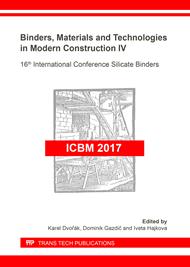[1]
Skripkiūnas, G.; Kičaitė, A.; Macijauskas, M. The influence of calcium nitrate on the plasticizing effect of cement past. Journal of civil engineering and management. Vilnius: Technika. Vol. 22, no. 3, p.434–441, (2016).
DOI: 10.3846/13923730.2015.1120771
Google Scholar
[2]
Skripkiūnas, G.; Daukšys, M.; Štuopys, A.; Levinskas, R. 2005. The influence of cement particles shape and concentration on the rheological properties of cement slurry. Materials Science (Medžiagotyra) 11(2): 150–158.
Google Scholar
[3]
Puertas, F.; Varga, C.; Alonso, M. M. 2014. Rheology of alkali-activated slag pastes. Effect of the nature and concentration of the activating solution, Cement and Concrete Composites 53: 279–288.
DOI: 10.1016/j.cemconcomp.2014.07.012
Google Scholar
[4]
Banfill, P. F. G. 2003. The rheology of fresh cement and concrete – a review, in Proc. of 11th International Cement Chemistry Congress, May 2003, Durban, South Africa, 1–13.
Google Scholar
[5]
Mewis, J. 1979. Thixotropy – A General Review, Journal of Non-Newtonian Fluid Mechanics, V. 6, p.1–20.
DOI: 10.1016/0377-0257(79)87001-9
Google Scholar
[6]
Saak, A. W.; Jennings, H. M.; Shah, S. P. The influence of wall slip on yield stress and viscoelastic measurements of cement paste. Cement and Concrete Research, vol. 31, no. 2, p.205–212, Feb. (2001).
DOI: 10.1016/s0008-8846(00)00440-3
Google Scholar
[7]
Connection between the rheology of concrete and rheology of cement paste,, ACI Materials Journal, vol. 89, no. 4, (1992).
DOI: 10.14359/2575
Google Scholar
[8]
Yahia, A.; Tanimura, M. Rheology of belite-cement – Effect of w/c and high-range water-reducer type,, Construction and Building Materials, vol. 88, p.169–174, Jul. (2015).
DOI: 10.1016/j.conbuildmat.2015.03.029
Google Scholar
[9]
Ng, S.; Justnes, H. Influence of dispersing agents on the rheology and early heat of hydration of blended cements with high loading of calcined marl. Cement and Concrete Composites, vol. 60, p.123–134, Jul. (2015).
DOI: 10.1016/j.cemconcomp.2015.04.007
Google Scholar
[10]
Macijauskas, M.; Gailius, A. Influence of cement type and admixtures on rheological properties of cement pastes. Engineering Structures and Technologies, vol. 5, no. 4, p.175–181, (2014).
DOI: 10.3846/2029882x.2014.912431
Google Scholar
[11]
Lapasin, R.; Papo, A.; Rajgelj, S. Flow behavior of fresh cement pastes. A comparison of different rheological instruments and techniques,, Cement and Concrete Research, vol. 13, no. 3, p.349–356, May (1983).
DOI: 10.1016/0008-8846(83)90034-0
Google Scholar
[12]
Nehdi, M.; Rahman, M.-A. Estimating rheological properties of cement pastes using various rheological models for different test geometry, gap and surface friction,, Cement and Concrete Research, vol. 34, no. 11, p.1993–2007, Nov. (2004).
DOI: 10.1016/j.cemconres.2004.02.020
Google Scholar
[13]
Billberg, P. (2006).
Google Scholar
[14]
Billberg, P. 2009. Stress-Strain Measurement Of Fresh SCC at Rest Using a Concrete Viscometer,, RILEM International Symposium on Rheology of Cement Suspensions such as Fresh Concrete, Reykjavik, Iceland, Aug., p.265–272.
Google Scholar
[15]
Petkova, V.; Samichkov, V. 2007. Some Influences on the Thixotropy of Composite Slag Portland Cement Suspensions with Secondary Industrial Waste,, Construction and Building Materials, V. 21, No. 7, July, p.1520–1527.
DOI: 10.1016/j.conbuildmat.2006.04.011
Google Scholar
[16]
Coussot, P.; Nguyen, Q. D.; Huynh, H. T.; Born, D. 2002. Viscosity Bifurcation in Thixotropy, Yielding Fluids,, Journal of Rheology, V. 46, No. 3, p.573–589.
DOI: 10.1122/1.1459447
Google Scholar
[17]
Ur'ev, N. B.; Baru, R. L.; Izhik, A. P.; Shoi, S. V.; Saaskovets, V. V. 1997. Rheology and Thixotropy of Cement-Water Suspensions in the Presence of Superplasticizers,, Colloid Journal, V. 59, No. 6, pp.773-779.
Google Scholar


